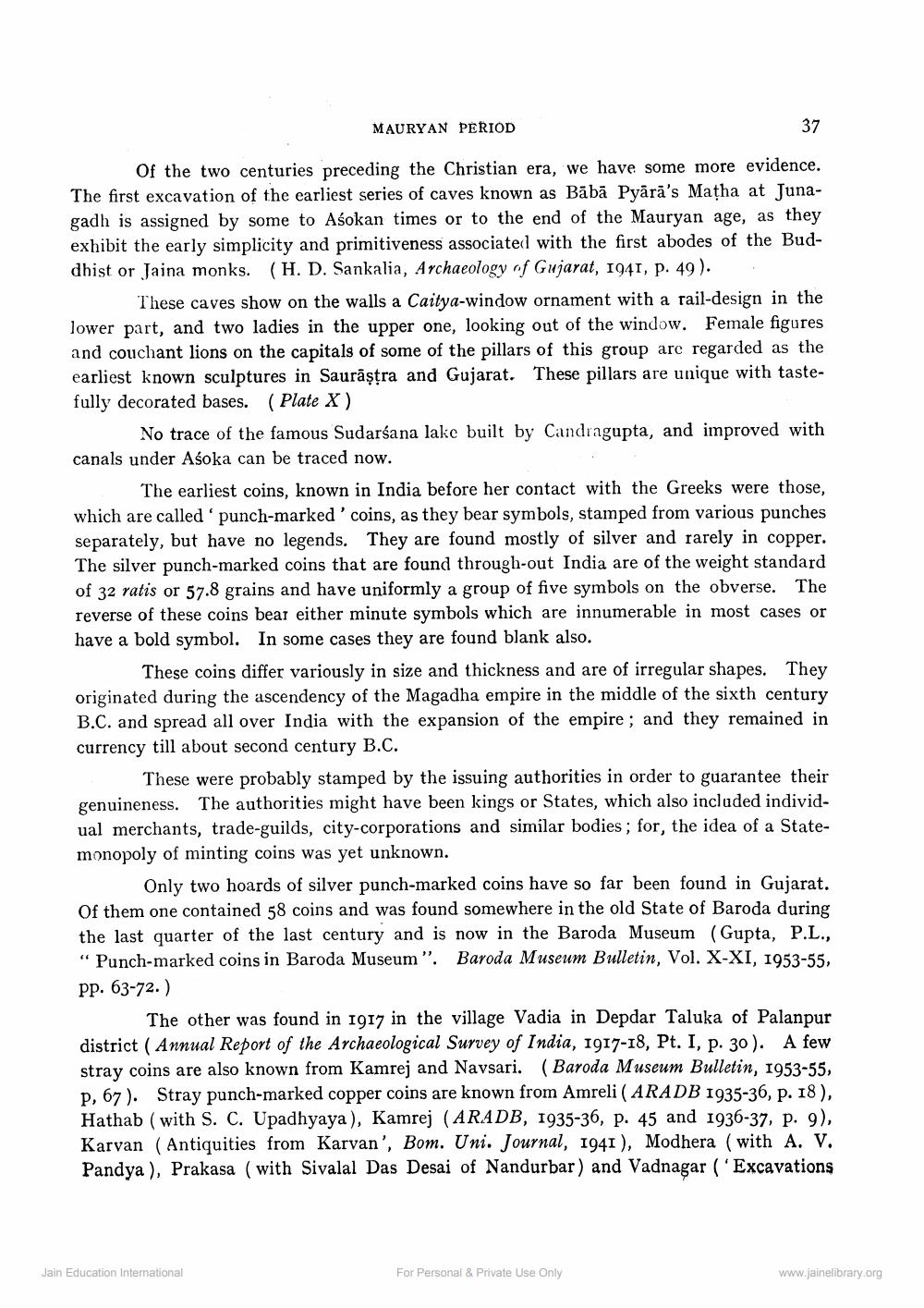________________
MAURYAN PERIOD
37
Of the two centuries preceding the Christian era, we have some more evidence. The first excavation of the earliest series of caves known as Bābā Pyārā's Matha at Junagadh is assigned by some to Asokan times or to the end of the Mauryan age, as they exhibit the early simplicity and primitiveness associated with the first abodes of the Buddhist or Jaina monks. (H. D. Sankalia, Archaeology of Gujarat, 1941, p. 49).
These caves show on the walls a Caitya-window ornament with a rail-design in the lower part, and two ladies in the upper one, looking out of the window. Female figures and couchant lions on the capitals of some of the pillars of this group are regarded as the earliest known sculptures in Saurāştra and Gujarat. These pillars are unique with tastefully decorated bases. (Plate X)
No trace of the famous Sudarsana lake built by Candragupta, and improved with canals under Asoka can be traced now.
The earliest coins, known in India before her contact with the Greeks were those, which are called 'punch-marked' coins, as they bear symbols, stamped from various punches separately, but have no legends. They are found mostly of silver and rarely in copper. The silver punch-marked coins that are found through-out India are of the weight standard of 32 ratis or 57.8 grains and have uniformly a group of five symbols on the obverse. The reverse of these coins bear either minute symbols which are innumerable in most cases or have a bold symbol. In some cases they are found blank also.
These coins differ variously in size and thickness and are of irregular shapes. They originated during the ascendency of the Magadha empire in the middle of the sixth century B.C. and spread all over India with the expansion of the empire ; and they remained in currency till about second century B.C.
These were probably stamped by the issuing authorities in order to guarantee their genuineness. The authorities might have been kings or States, which also included individual merchants, trade-guilds, city-corporations and similar bodies ; for, the idea of a Statemonopoly of minting coins was yet unknown.
Only two hoards of silver punch-marked coins have so far been found in Gujarat. Of them one contained 58 coins and was found somewhere in the old State of Baroda during the last quarter of the last century and is now in the Baroda Museum (Gupta, P.L., "Punch-marked coins in Baroda Museum". Baroda Museum Bulletin, Vol. X-XI, 1953-55, pp. 63-72.)
The other was found in 1917 in the village Vadia in Depdar Taluka of Palanpur district ( Annual Report of the Archaeological Survey of India, 1917-18, Pt. I, p. 30). A few stray coins are also known from Kamrej and Navsari. (Baroda Museum Bulletin, 1953-55, p, 67). Stray punch-marked copper coins are known from Amreli (ARADB 1935-36, p. 18), Hathab (with S. C. Upadhyaya), Kamrej (ARADB, 1935-36, p. 45 and 1936-37, p. 9), Karvan (Antiquities from Karvan', Bom. Uni. Journal, 1941 ), Modhera (with A. V. Pandya ), Prakasa ( with Sivalal Das Desai of Nandurbar) and Vadnagar ('Excavations
Jain Education Intemational
For Personal & Private Use Only
www.jainelibrary.org




